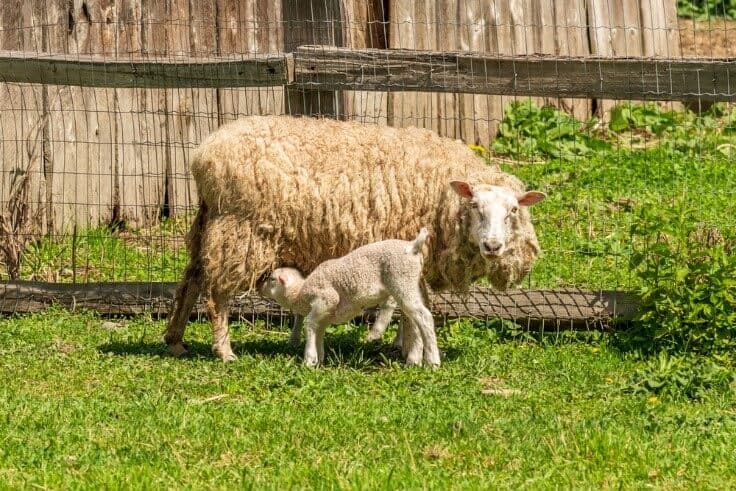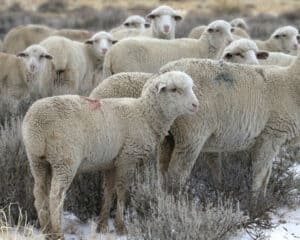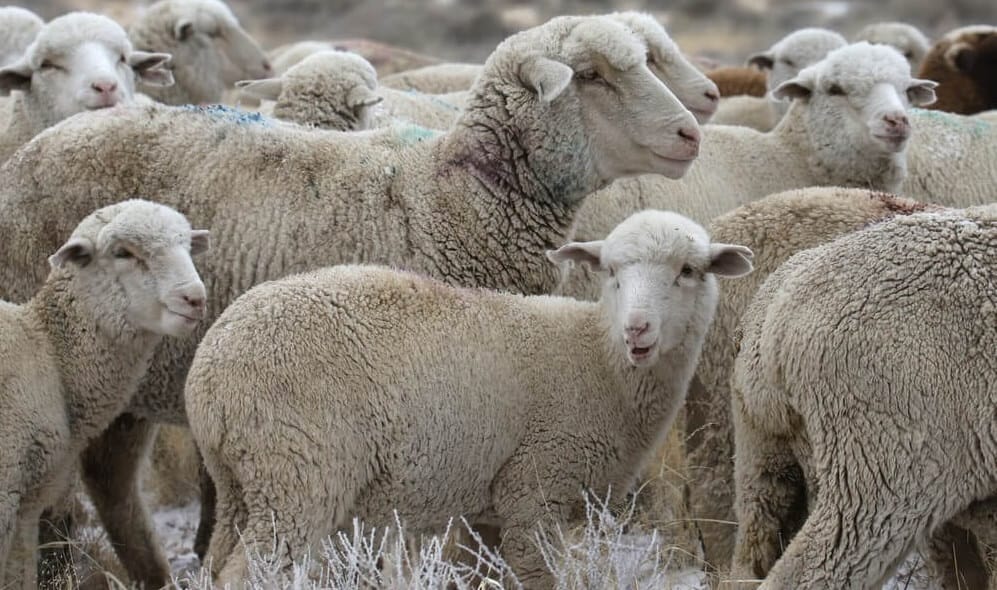Columbia sheep were bred specifically for their fine wool production capabilities. They also produce excellent meat. It’s considered lean and succulent. Being dual purpose, many hobby farmers choose Columbias to help them reach their productivity goals.
If you are in the market for an American breed of sheep that is excellent at producing wool, you might want to raise Columbia sheep.
Before bringing sheep to your property, keep in mind you must plan to raise a minimum of 5 sheep together. Sheep are social animals and also derive protection from being in a flock.
Purpose for Raising Columbia Sheep
There are several good reasons sheep farmers favor the Columbia sheep breed.
Excellent wool production
This is the main reason this particular breed exists. Columbia sheep produce medium wool. Their fleeces can weigh around 10 – 15 pounds.
Adaptable
The best part is that this particular sheep can thrive in almost any climate.
Dual-purpose sheep
They are not only good for wool production. Since they are large, these sheep also double as excellent meat producers. Their meat is known to be lean, succulent, and tender.
This medium wool breed also produces quite a bit of milk and are known as prolific breeders, which means that with the right kind of farm management, you can easily increase the number in your flock.
They are hardy
Even though these sheep were bred for the western ranges, they quickly became a favorite breed across the country. This is because they are hardy, resilient, and can survive in almost any weather.
Wool Production
Bred to produce large quantities of wool, these sheep yield medium wool and thick fleece of desirable length.
- Grease fleece weight: Ewe (12 – 16 lbs)
- Yield: 45-55%

Columbia Sheep Breed Appearance and Characteristics
One of the main reasons the Columbia breed has become so popular in the United States is that they are quite large. They are known to produce a medium, white fleece. Columbia ewes are so large that they are a popular breed for crossbreeding in most commercial western flocks.
The Columbia breed is generally white with white faces. You will typically find these sheep with wool all over their bodies. They closely resemble the Corriedale sheep but are larger. Unlike the Corriedale sheep, which have black muzzles and feet, the Columbia breed has pink noses and white hooves.
Apart from the fact that the Columbia sheep produce a great deal of fleece, they are also quite a versatile and hardy breed. They are ideal for farmers who are looking to maximize their production of meat as well as wool.
As far as size is concerned, the Columbia breed is considered one of the largest sheep breeds in the US. The biggest sheep breeds are designed for wool production. They typically don’t have horns.
Columbia are a larger-framed sheep with mature weights ranging from 225 to 300 pounds. Their body weight is:
- Columbia ram: 250 – 350 pounds
- Columbia ewe: 160 – 240 pounds

Reproduction
Columbia sheep are known to be prolific breeders. The ewes have excellent mothering instincts and can take good care of their young. Regarding their estrous cycles, the ewes come into heat on average every 15 to 20 days, and the breeding cycles last for around 24 to 36 hours.
Like every other sheep breed, Columbia sheep have a gestation period between 149 days and around 155, with most gestation periods falling at the 152-day mark.
In many cases, the ewes will have a lactation period of about 150 to 240 days, but most of them can be milked for about 180 days. While they are mostly bred for their heavy medium wool fleece, they produce good quality milk too.
Columbia Sheep Origin and History
The Columbia sheep, recognized by the Columbia Sheep Breeders Association as the first all-American sheep breed, marks a significant milestone in the United States’ agricultural history. Originating in 1912, this breed was created through the strategic crossbreeding of Lincoln rams and Rambouillet ewes, a process undertaken by the United States Department of Agriculture.
The primary goal was to develop a breed capable of producing an increased yield of fine wool and lambs, while also being robust enough to thrive in the harsh range conditions of the Western United States.
This breed not only met these criteria but also exceeded expectations by quickly gaining popularity across North America for its versatility. Particularly noted for their large size, Columbia ewes are prized for their ability to produce significant quantities of wool, making them an excellent choice for producing crossbred market lambs.
The first successful crossbreed, which laid the foundation for the Columbia breed, emerged from the combination of Rambouillet ewes and long-wooled rams, proving to be the most promising among various crosses. This initial crossbreeding effort took place in Laramie, Wyoming.
By 1918, the establishment of the Foundation of the Government Columbia flock was relocated to the Sheep Experiment Station in Dubois, Idaho, cementing the breed’s status as a cornerstone in American sheep farming.
FAQs
What kind of temperament do Columbia sheep have?
Columbia sheep are typically even-keeled and docile. However, since they are large, farmers shouldn’t leave children unsupervised around them. Especially not during the mating season, when the rams can be quite aggressive.
How easy is it to care for Columbia sheep?
Columbia sheep are like goats in that they like grazing. Caring for them involves enclosing them in the ideal pasture and letting them graze their way through. Once they are done with one patch of land, rotating pasture is necessary.
Do Columbia sheep suffer from any diseases in particular?
Columbia sheep aren’t afflicted by any particular diseases. They are quite hardy and only need veterinary care for regular check-ups and deworming.
Raising Columbia Sheep
Few sheep breeds in the sheep industry are quite as versatile as the Columbia sheep. Ideal for wool production, these sheep are dual-purpose and can give you a good amount of meat. They are easy to care for and can survive almost anywhere.
Other white-faced crossbreeds are Corriedale and Targhee. They are each considered medium-wool breeds and are very productive when they have an ample food supply. Their breeding season is more restricted than fine-wool sheep. In addition, their fleeces typically vary more in fineness of grade.
When raising sheep, you’ll need to plan for shearing them. This keeps them cool. While many people hire professionals, you can also learn how to shear a sheep yourself.
Other wool sheep breeds to learn about are Ouessant sheep, Icelandic sheep, Rambouillets, and Merino sheep. Another breed, Texel sheep, produces wool that is used to make knitting wools and hosiery yarns. Hair sheep, which grow coarse hair instead of wool are Barbados sheep, Dorper, Royal White, and St. Croix.
If you are considering adding sheep to your backyard farm or homestead, consider why you want to raise them. If you are looking for a wool and a meat source, Columbia sheep are a multipurpose breed.
It’s important to raise more than one sheep together because they are social. A minimum of five is necessary. Sheep also derive security and protection when they are in a flock. Learn how many sheep per acre you can reasonably keep on your property to help ensure a healthy flock.
- How Much Does a Sheep Cost
- Fat Tailed Sheep – Everything You Need to Know
- How Long Do Sheep Live and What Affects Sheep Lifespan
- Best Sheep Names for Your Flock
- Purposes for raising Lamb vs Sheep

